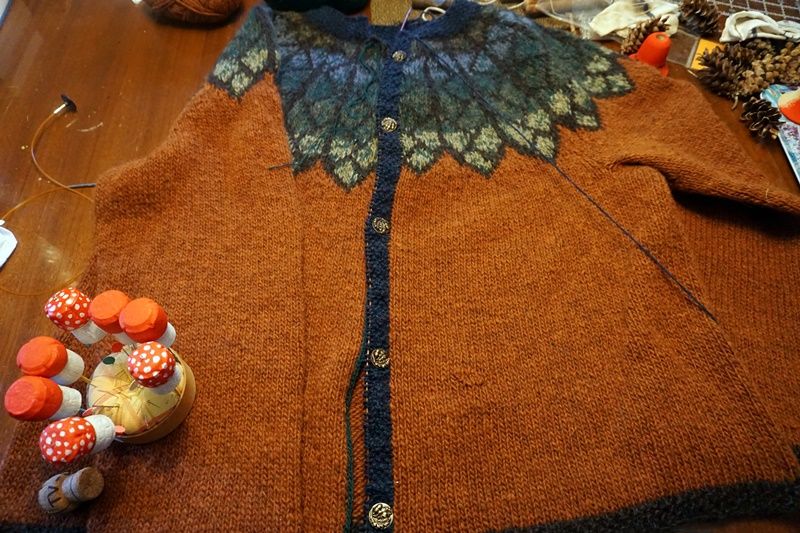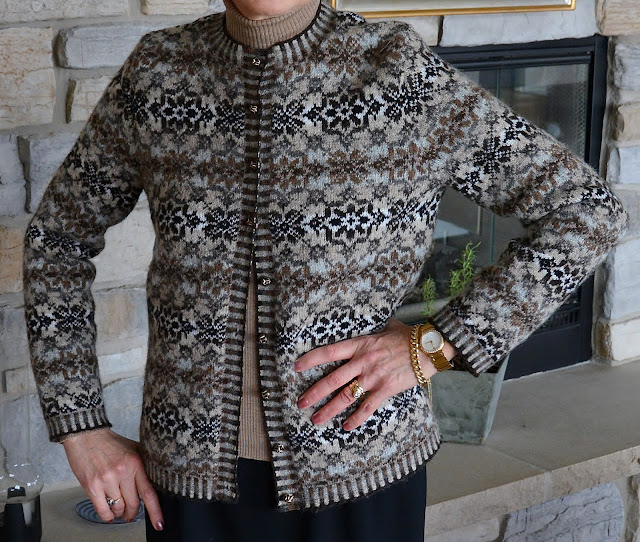This old dog learned some new tricks
-
@AdagioM I did! This is after I'd cut it up the front and knit one of the button bands and new collar, but had not yet sewn the buttons on. They were just placed here to see how they'd look. (It turns out I'm going to re-do the button hole band and use bigger buttons.) This poor sweater! It's been through so much. I wasn't pleased with the drape as a pull-over, I love the drape as a cardigan but the button bands need re-working. It's had attacks from moths which I've patched. And I wish I hadn't made it quite so roomy. No matter, it's basically an "at home" cardigan. I do love the pattern and it's very warm.

-
@Bernard If I actually do this, I might pick up the button bands before cutting. Belt and suspenders, doncha know! and needle felt the actual cutting area. That’s a fun way to reinforce.
-
@AdagioM Good idea. Before I cut, I used a crochet hook to pick up and chain stitch up both sides of where I was going to cut.
-
-
@Bernard I teach several methods in my steeks class, including slip stitch crochet and single crochet, backstitch, and needle felting! We talk about sewing machines, but I wouldn’t trust my knits to a sewing machine, ever.
@AdagioM said in This old dog learned some new tricks:
@Bernard I teach several methods in my steeks class, including slip stitch crochet and single crochet, backstitch, and needle felting! We talk about sewing machines, but I wouldn’t trust my knits to a sewing machine, ever.
I saw that you are teaching a steeking class in the near future. I just can't wrap my brain around cutting something knit....
-
@Bernard I teach several methods in my steeks class, including slip stitch crochet and single crochet, backstitch, and needle felting! We talk about sewing machines, but I wouldn’t trust my knits to a sewing machine, ever.
-
@AdagioM said in This old dog learned some new tricks:
@Bernard I teach several methods in my steeks class, including slip stitch crochet and single crochet, backstitch, and needle felting! We talk about sewing machines, but I wouldn’t trust my knits to a sewing machine, ever.
I saw that you are teaching a steeking class in the near future. I just can't wrap my brain around cutting something knit....
@wtg That’s what makes it so fun…it’s marginally terrifying! But not really.
It’s easier to knit stranded colorwork in the round than flat, because the colorwork pattern is always facing you. No purling back in pattern. But if you want a flat piece of knitting (or a cardigan) when you’re done, you need to cut it so it’s not in the round any more!
-
@AdagioM My first steek was secured with a sewing machine. Slow and easy, wide foot. It went OK.
-
@wtg That’s what makes it so fun…it’s marginally terrifying! But not really.
It’s easier to knit stranded colorwork in the round than flat, because the colorwork pattern is always facing you. No purling back in pattern. But if you want a flat piece of knitting (or a cardigan) when you’re done, you need to cut it so it’s not in the round any more!
@AdagioM Yes, my friend used to do a ton of stranded colorwork in the round and it is from her that I learned about steeking. I was also the beneficiary of one of her early attempts which turned out much too large for her because she did her gauge swatch flat but when she knit the actual sweater in the round it grew like Alice!
Some of her work:



I love this:
.jpg)
She was an amazing and incredibly prolific knitter!
-
My friend who knitted these sweaters was wicked smart and a doggedly determined person, both in knitting and in life. I have never done this kind of knitting but from what little I know of how it's done I do think it can be quite challenging. @Bernard or @AdagioM probably have a better idea of the difficulty factor from the viewpoint of experienced knitters.
A few more pics:
My friend not only knit, but also did her own designs. Here's an example of the evolution of one design. This one started with choosing the colors for this tam:
Which morphed into a design for this sweater:
And into some other color palettes:
For me, at least, eyes crossed....
-
Fair Isle patterns, in themselves, are not difficult as long as only two colors are used in the same row, which is usually the case. The sweater I posted above has some rows where three colors are needed and I found that it took more attention to carrying the threads. Once a person is comfortable using two colors at once (some people carry a different color in each hand, some carry both colors in the same hand), they are set to go. The pattern takes care of itself. It's like following a recipe. More often than not the pattern is given in the form of a chart which gets repeated horizontally and vertically.
A typical chart:
 ]
]wtg, your friend's sweaters are stunning.









